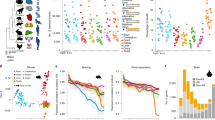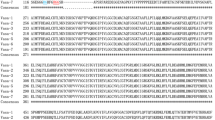Abstract
Many basic cellular processes are shared across vast phylogenetic distances, whereas sex-determining mechanisms are highly variable between phyla, although the existence of two sexes is nearly universal in the animal kingdom. However, the evolutionarily conserved DMRT1/dsx/mab3 with a common zinc finger-like DNA-binding motif, DM domain, share both similar structure and function between phyla. Here we report that six transcripts of the chicken DMRT1 were generated in gonads by multiple alternative splicing. By cDNA cloning and genomic structure analysis, we found that there were nine exons of DMRT1, which were involved in alternatively splicing to generate the DMRT1 transcripts. Northern blotting and reverse transcription (RT) PCR analysis revealed that the expression of chicken DMRT1 was testis-specific in adults. Whole-mount in situ hybridizations and RT-PCR indicated that DMRT1 b was specially expressed in embryo gonads and higher in male than female gonads at stage 31. The female gonad had stronger DMRT1 c expression than the male one, whereas DMRT1 f was detectable only in the male gonad at stage 31 of the key time of sex gonadal differentiation. The differential expression of these transcripts during gonadal differentiation provides new insight into roles of alternative splicing of DMRT1 in governing sex differentiation of the chicken.






Similar content being viewed by others
References
Burtis KC, Baker BS (1989) Drosophila doublesex gene controls somatic sexual differentiation by producing alternatively spliced mRNAs encoding related sex-specific polypeptides. Cell 56:997–1010
Cheng HH, Ying M, Tian YH, Guo Y, McElreavey K, Zhou RJ (2006) Transcriptional diversity of DMRT1 (dsx- and mab3-related transcription factor 1) in human testis. Cell Res 16:389–393
Flejter WL, Fergestad J, Gorski J, Varvill T, Chandrasekharappa S (1998) A gene involved in XY sex reversal is located on chromosome 9, distal to marker D9S1779. Am J Hum Genet 63:794–802
Griffiths R, Double MC, Orr K, Dawson RJ (1998) A DNA test to sex most birds. Mol Ecol 7:1071–1075
Grutzner F, Rens W, Tsend-Ayush E, El-Mogharbel N, O’Brien PC, Jones RC, Ferguson-Smith MA, Marshall Graves JA (2004) In the platypus a meiotic chain of ten sex chromosomes shares genes with the bird Z and mammal X chromosomes. Nature 432:913–917
Guioli S, Schmitt K, Critcher R, Bouzyk M, Spurr NK, Ogata T, Hoo JJ, Pinsky L, Gimelli G, Pasztor L, Goodfellow PN (1998) Molecular analysis of 9p deletions associated with XY sex reversal: refining the localization of a sex-determining gene to the tip of the chromosome. Am J Hum Genet 63:905–908
Guo Y, Cheng H, Huang X, Gao S, Yu H, Zhou R (2005) Gene structure, multiple alternative splicing, and expression in gonads of zebrafish Dmrt1. Biochem Biophys Res Commun 330:950–957
Hori T, Asakawa S, Itoh Y, Shimizu N, Mizuno S (2000) Wpkci, encoding an altered form of PKCI, is conserved widely on the avian W chromosome and expressed in early female embryos: implication of its role in female sex determination. Mol Biol Cell 11:3645–3660
Huang X, Guo Y, Shui Y, Gao S, Yu H, Cheng H, Zhou R (2005) Multiple alternative splicing and differential expression of dmrt1 during gonad transformation of the rice field eel. Biol Reprod 73:1017–1024
Koopman P, Gubbay J, Vivian N, Goodfellow P, Lovell-Badge R (1991) Male development of chromosomally female mice transgenic for SRY. Nature 351:117–121
Kriventseva EV, Koch I, Apweiler R, Vingron M, Bork P, Gelfand MS, Sunyaev S (2003) Increase of functional diversity by alternative splicing. Trends Genet 19:124–128
Matsuda M, Nagahama Y, Shinomiya A, Sato T, Matsuda C, Kobayashi T, Morrey CE, Shibata N, Asakawa S, Shimizu N, Hori H, Hamaguchi S, Sakaizumi M (2002) DMY is a Y-specific DM-domain gene required for male development in the medaka fish. Nature 417:559–563
McQueen HA, McBride D, Miele G, Bird AP, Clinton M (2001) Dosage compensation in birds. Curr Biol 11:253–257
Nanda I, Shan Z, Schartl M, Burt DW, Koehler M, Nothwang H, Grutzner F, Paton IR, Windsor D, Dunn I, Engel W, Staeheli P, Mizuno S, Haaf T, Schmid M (1999) 300 million years of conserved synteny between chicken Z and human chromosome 9. Nat Genet 21:258–259
Nanda I, Kondo M, Hornung U, Asakawa S, Winkler C, Shimizu A, Shan Z, Haaf T, Shimizu N, Shima A, Schmid M, Schartl M (2002) A duplicated copy of DMRT1 in the sex-determining region of the Y chromosome of the medaka, Oryzias latipes. Proc Natl Acad Sci USA 99:11778–11783
Narendra U, Zhu L, Li B, Wilken J, Weiss MA (2002) Sex-specific gene regulation. The Doublesex DM motif is a bipartite DNA-binding domain. J Biol Chem 277:43463–43473
Ottolenghi C, Veitia R, Quintana-Murci L, Torchard D, Scapoli L, Souleyreau-Therville N, Beckmann J, Fellous M, McElreavey K (2000) The region on 9p associated with 46,XY sex reversal contains several transcripts expressed in the urogenital system and a novel doublesex-related domain. Genomics 64:170–178
Raymond CS, Shamu CE, Shen MM, Seifert KJ, Hirsch B, Hodgkin J, Zarkower D (1998) Evidence for evolutionary conservation of sex-determining genes. Nature 391:691–695
Raymond CS, Kettlewell JR, Hirsch B, Bardwell VJ, Zarkower D (1999a) Expression of Dmrt1 in the genital ridge of mouse and chicken embryos suggests a role in vertebrate sexual development. Dev Biol 215:208–220
Raymond CS, Parker ED, Kettlewell JR, Brown LG, Page DC, Kusz K, Jaruzelska J, Reinberg Y, Flejter WL, Bardwell VJ, Hirsch B, Zarkower D (1999b) A region of human chromosome 9p required for testis development contains two genes related to known sexual regulators. Hum Mol Genet 8:989–996
Raymond CS, Murphy MW, O’Sullivan MG, Bardwell VJ, Zarkower D (2000) Dmrt1, a gene related to worm and fly sexual regulators, is required for mammalian testis differentiation. Genes Dev 14:2587–2595
Reed KJ, Sinclair AH (2002) FET-1: a novel W-linked, female specific gene up-regulated in the embryonic chicken ovary. Mech Dev 119(Suppl 1):S87–S90
Shan Z, Nanda I, Wang Y, Schmid M, Vortkamp A, Haaf T (2000) Sex-specific expression of an evolutionarily conserved male regulatory gene, DMRT1, in birds. Cytogenet Cell Genet 89:252–257
Sinclair AH, Berta P, Palmer MS, Hawkins JR, Griffiths BL, Smith MJ, Foster JW, Frischauf AM, Lovell-Badge R, Goodfellow PN (1990) A gene from the human sex-determining region encodes a protein with homology to a conserved DNA-binding motif. Nature 346:240–244
Smith CA, McClive PJ, Western PS, Reed KJ, Sinclair AH (1999) Conservation of a sex-determining gene. Nature 402:601–602
Smith CA, Katz M, Sinclair AH (2003) DMRT1 is upregulated in the gonads during female-to-male sex reversal in ZW chicken embryos. Biol Reprod 68:560–570
Vidal VP, Chaboissier MC, de Rooij DG, Schedl A (2001) Sox9 induces testis development in XX transgenic mice. Nat Genet 28:216–217
Zarkower D (2001) Establishing sexual dimorphism: conservation amidst diversity? Nat Rev Genet 2:175–185
Acknowledgements
The work was supported by the National Natural Science Foundation of China, and the National Key Basic Research project, the Program for New Century Excellent Talents in University, and the 111 project #B06018. There is not any financial conflict of interest. The first two authors contributed to the work equally.
Author information
Authors and Affiliations
Corresponding authors
Additional information
Communicated by B.G. Herrmann
Rights and permissions
About this article
Cite this article
Zhao, Y., Lu, H., Yu, H. et al. Multiple alternative splicing in gonads of chicken DMRT1 . Dev Genes Evol 217, 119–126 (2007). https://doi.org/10.1007/s00427-006-0117-0
Received:
Accepted:
Published:
Issue Date:
DOI: https://doi.org/10.1007/s00427-006-0117-0




